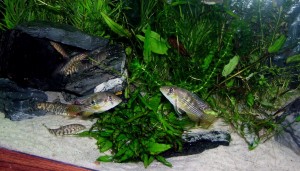At a recent meeting of the Capital Cichlid Association, CCA member Matt Quinn recounted his trip to Uruguay. According to Wikipedia, Uruguay is in Southeastern South America, South of Brazil and East of Argentina. In South America, Matt said, Uruguay is best known as a vacation destination, primarily because of its beautiful beaches. The northern part of the country is warmer, like Miami, while the South is cooler, with a climate like Tampa. The people are regarded as outgoing and friendly, the environment safe. Because the climate is subtropical, Matt said, he didn’t need to get vaccinated against any tropical diseases. Matt and his family flew into Buenos Aires, and then made the 2 1/2 hour trip across the Rio de La Plato to Colonia. Matt traveled with Aqva Terra, a guided tour service run by Felipe Cantera. The group visited two sites in the south of the country, and two further north. Understandably, Matt’s talk focused on Uruguay’s cichlids:
–Gymnogeophagus, which means “naked eartheaters,” so named because they lack cheek scales.
-Chanchitos, or eastern Australoheros. “Chanchito” means “little pig” in Spanish. (These fish are said to eat a lot.)
-Acaras (Cichlasoma species).
–Crenicichla, or pike cichlids. These are ambush predators bearing a superficial resemblance to the true pike found in North America and Europe
–Apistogrammas, the dwarf cichlid family found throughout South America.

The Gymnogeophagus rhabdotus I got from Matt last year, in a community tank with zebra and yo yo loaches.
With the exception of some mouthbrooding species
Geophagus (
gymnogenys,
labiatus,
tiraparae, and
australis) all of these cichlids are substrate spawners. In general, Matt said, Uruguay’s cichlids are only mildly aggressive, and so shouldn’t be kept with tough aggressive species such as those from Central America. Although they will pick off any fish they can swallow, the smaller pike cichlids aren’t too agressive with other cichlid species. To keep smaller pikes form killing each other, they should be housed with other cichlids. Aquarium care is simple, and all of the Uruguay cichlids will take flake and other prepared foods. Because Uruguay has seasonal temperature changes, Uruguayan cichlids benefit from a cooling off period–particularly the
Gymnogeophagus. In southern Uruguay, temperatures can drop into the 30s and 40s (Fahrenheit). Matt recommended that Gymnogeophagus be kept in the coolest room in the house, in an unheated tank. If needed, a heater can be used to bring the temperature up for part of the year, into the mid 70s. Matt cautioned against keeping Uruguayan cichlids warm for too long. If the fish don’t take a break from spawning, he said, they typically develop hole-in-the-head disease or some other illness. Because of their wide temperature tolerance, Uruguayan cichlids often do well in backyard ponds in the spring through early fall. Any of a number of fish that tolerate cooler water can be used as dithers Uruguayan cichlids, he said, including Buenos Aires tetras, bloodfin tetras and serpae tetras, goodeids, swordtails and platies, and White Cloud Mountain minnows. Matt added thatyou shouldn’t shock Urugayan cichlids with a cool water change to trigger spawning as you might do with some Amazonian species.Along with cichlids, Matt said, Uruguay has a number of other interesting species, including
corydoras,
ancistrus,
farlowella, and other catfish species, killies, knife fish, and live bearers.

